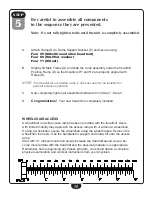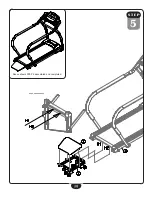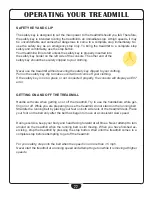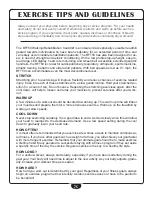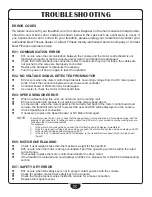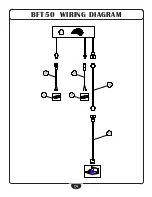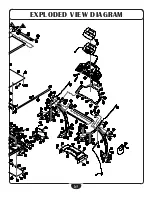
27
exercise Tips anD guiDelines
There are two ways to measure your exercise intensity. The first is by evaluating your per-
ceived exertion level and the second is by monitoring your heart rate. During exercise, if you
cannot maintain a conversation without gasping, you are working too hard. A good rule of
thumb is to work to the point of exhilaration, not exhaustion. If you cannot catch your breath,
it is time to slow down. Always be aware of other warning signs to overexertion.
To monitor your heart rate you can use a pulse monitor or take your pulse with your fingers.
Pulse monitors are convenient tools for monitoring your heart rate. However, these values
are for reference only. You should always listen to your body first.
You can measure your pulse with your fingers by placing your first two fingers lightly over
the blood vessel (carotid artery) on your neck located next to your Adam’s apple. Count your
pulse for ten seconds and multiply by six. This figure is your heart rate in beats per minute
(bpm). Compare this number to the Target Heart rate zone for your age group.
WaLking tipS
Before attempting your first workout and have consulted with a physician, familiarize
yourself with the console and all the safety controls. It is imperative that the user is
appropriately dressed and is using running shoes while working out. See the Safety
Guidelines section for more information.
A novice user should hold onto the extended handrails as the treadmill is starting.
Straddle the treadmill as it begins to move and use only one foot to get the rhythm
of how quickly the user needs to walk.
Start at the lowest walking speed and as you become more comfortable, increase
speeds in small increments (0.1 mph at a time) to ensure that the user is in control
of the machine.
Eyes forward and remember to use good posture. Do not look sideways, down or
backwards! There is a tendency to walk in the direction you are looking at.
Use the wheelchair access ramp if mounting onto the treadmill becomes strenuous
on the knees.
age
target Zone
20
120 ~ 150
25
117 ~ 146
30
114 ~ 142
35
111 ~ 138
40
108 ~ 135
45
105 ~ 131
50
102 ~ 127
55
99 ~ 123
60
96 ~ 120
65
93 ~ 116
70
90 ~ 113
taRget heaRt Rate
taRget heaRt Rate
The most common method for calculating your target
heart rate is to find your maximum heart rate.
The standard formula for this is:
220 - your age = M
axiMuM
H
eart
r
ate
.
You DO NOT want to workout at your maximum heart
rate. You want to workout in your target heart rate zone.
Your target heart rate zone is a percentage of your maxi-
mum heart rate. The American Heart Association recom-
mends working out at a target heart rate zone of between
60% - 75% of your maximum heart rate. If you are just
beginning an exercise program, exercise near or below
the lower limit of your target zone.
L
ower
t
arget
Z
one
L
iMit
= M
axiMuM
H
eart
r
ate
x
0.60
u
pper
t
arget
Z
one
L
iMit
= M
axiMuM
H
eart
r
ate
x
0.75
Summary of Contents for BFT50
Page 1: ...BFT50 O w n e r s M a n u a l v 091709...
Page 11: ...11 S T EP 1 Above shows STEP 1 assembled and completed...
Page 13: ...13 S T EP 2 Above shows STEP 2 assembled and completed...
Page 15: ...15 S T EP 3 Above shows STEP 3 assembled and completed...
Page 17: ...12 17 S T EP 4 Above shows STEP 4 assembled and completed...
Page 19: ...19 S T EP 5 Above shows STEP 5 assembled and completed...
Page 39: ...39 BFT50 Wiring Diagram...
Page 40: ...40 Exploded View Diagram...
Page 41: ...41 Exploded View Diagram...
Page 42: ...42 Notes...
Page 43: ...43 Notes...






